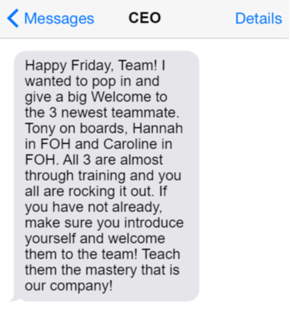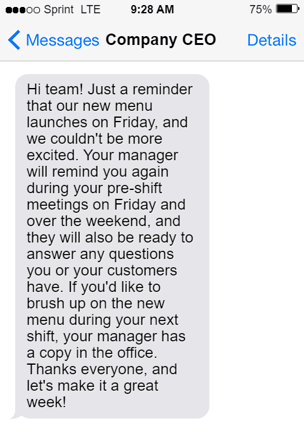Studies show frontline employees feel undervalued and disconnected from their leaders, causing a lack in commitment, engagement and contributions to the workplace. However, companies that invest in engaging frontline team members have seen positive results like higher revenues, productivity and lower turnover. HBR Analytic Services reported that 87% of nearly 500 business executives said they will be more successful when frontline workers are empowered to make important decisions in the moment.
With the ongoing staffing shortages, employers need a quick and effective way to engage with the Frontline to make them feel seen, heard and appreciated.
Mobile-Based Communications
Employee communications via mobile-based tools and platforms is a growing trend that makes communicating to Frontline team members in a timely and meaningful way simple. But choosing the right platform is just as important as communicating in the first place.
Many mobile communications solutions are app-based, meaning each individual employee on the receiving end must download an app before employers can reach them. This creates disparities and reduces the chance that communications will be received - the average adoption rate by frontline employees for app-based solutions is 40% at best, and many of those who do opt in don’t keep their notifications turned on. Pew research shows that 19% of the phones used by adults who earn less than $30,000 per year are basic phones, not smartphones, leaving them out of company communications.
When adopting a solution, it’s important to find app-free offerings that deliver messages directly via text message – even basic phones have the ability to receive texts, not to mention GoHappy customers report a 99% open rate on all text-based company communications.
Empowering Your Frontline
More than anything, the ways in which leadership and management teams communicate is what will drive employees' levels of engagement. The smallest day-to-day interactions and praises for success can make a huge difference. A few ways employers can do this include:
- Recognizing employees.
Make your employees feel appreciated by celebrating their good work and acknowledging milestones like 10 years of employment or even their first day.
This goHappy customer uses text messaging to welcome new hires. Names have been changed or removed to respect the privacy of our customers and their staff.

- Listening to employees’ opinions, ideas and feedback.
Create a company culture where employees feel safe and empowered to share their ideas or constructive criticism about company policies.
- Keeping people informed.
From COVID-19 policies and procedures to new menu items or recruitment incentives, it’s important to ensure all frontline employees receive updates that could impact their work.
This goHappy customer uses text messaging to relay menu updates to frontline team members. Names have been removed to respect the privacy of our customers and their staff.

- Coaching and developing the team.
Just as important as investing in training and upskilling opportunities for employees is ensuring they know about those resources. This helps to build confidence in the work they do, bettering their careers and productivity.
- Set clear expectations.
Set performance expectations, provide feedback, and inspire the team to work together toward shared goals.
How, what and when leaders communicate determines to a large extent the employees’ perception of their overall workplace experience and their desire to be engaged. And it’s clear that the level of engagement of your frontline employees directly impacts your bottom line.
For more information about how to tap into your Frontline’s full potential through effective communications, download the white paper below.









.webp)

